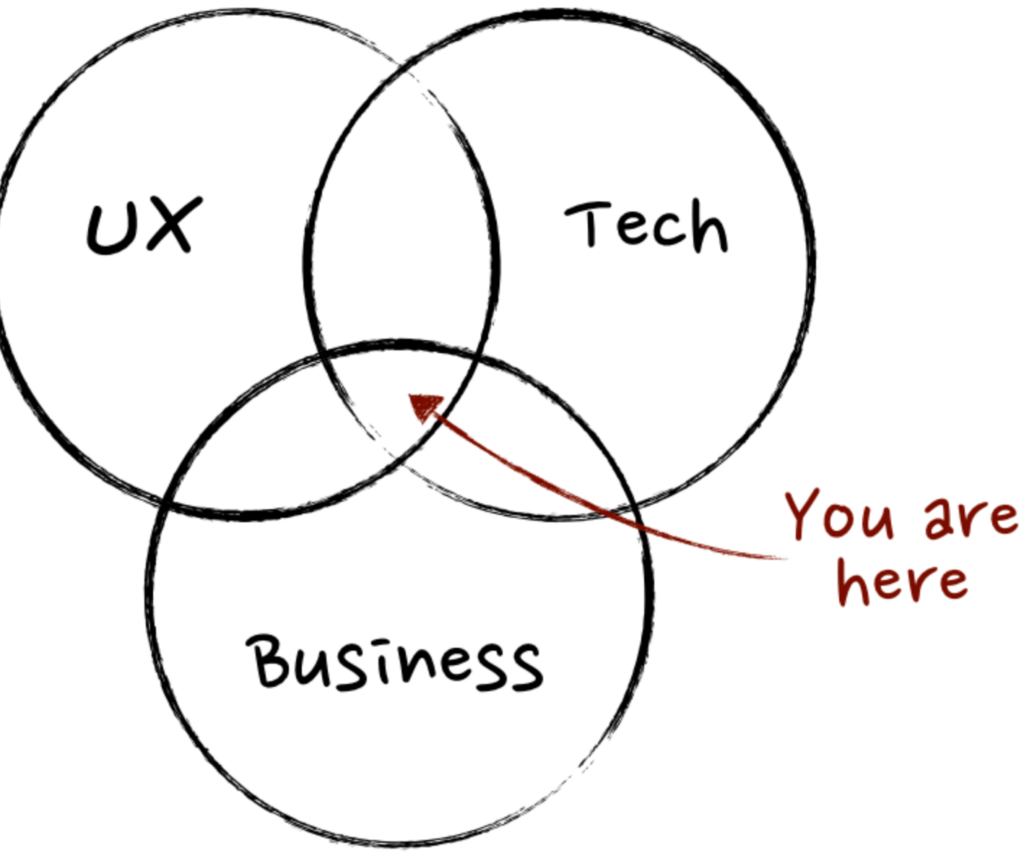What is value?
When product managers think about building a new product, usually the most used tool is the popular Venn diagram (see below) where users (or UX), tech and business intersect showing the product in the center of it all. It displays value from the product by creating something that is valuable for users, feasible from the technological standpoint and viable from a business perspective. To create a brand new product, usually literature points to users as our starting point, however, what does value mean for our users? How do we know we’re building something that will be useful, therefore helping them in a certain way?

JTBD basics
The jobs to be done (JTBD) framework has been around for some time now. This basic framework has been supporting product managers around the world to create value for users. Let’s take a look at what it entails. The main concept begins by explaining what a job is: users “hire” a product or service to achieve something specific in their lives, i.e. a job. This may sound simple, however, it’s a key differentiating factor to segment users strategically compared to a traditional customer segmentation. Think about it for a second: how do you normally segment according to marketing techniques? Demographics come to mind, right? Well, the jobs to be done framework scraps that concept completely. Here what matters is what is the user trying to get done, which could be a functional, emotional, or even a social matter.
- A functional job to be done is basically what a common task could be like, for example Google Docs -the software product I’m using to scribble this down- is helping me draft an article easily, or let’s say Reforge is a platform that can help me acquire a new product management skill or knowledge. One thing to consider with functional jobs are that they are solution-agnostic, meaning that it doesn’t matter what tool or product they used to solve a problem, they just happen to use it because it’s what’s at hand, so even if the product evolves it will still be (most of times) a functional job to be done representing a core need.
- Emotional jobs to be done: we’re thinking here about our feelings and needs related to them, for example Better Help is a platform that can connect me to a therapist that will actually work on my emotional well-being. However, there are other platforms as well that support another kind of emotional need: sense of accomplishment. Does Instagram ring a bell? This kind of job wants to capture a certain desire, even an unconscious one, that a user may have as a motivation to get something done.
- Social jobs to be done are similar to emotional ones. The main difference is while the latter addresses a psychological need, the former handles the perception of a group of people when a user gets a job done. Let’s say, for example, you want to seek advice on something specific and get an opinion from peers, here you may turn to Yelp or Reddit. When a person is in need of approval from other people or the image they want to project onto others is the most important thing, then it’s a social job.
JTBD & user empathy
So, why is it so important to understand which job and what kind of job are my users looking for when they want to achieve something? When product managers use this framework they are using it to uncover the whole journey of that specific user to get their job done, no matter which kind. This is the key aspect of the framework in my opinion, because it is forcing product managers, user experience specialists, or any person to fully empathize and understand the process the user needs to go through currently (in the framework they use the term “job mapping” for this step). It’s here where the actual “customer-centricity” gets the fame from, as it’s through interviews, shadowing or observation that we get to live in the customer’s shoes and “walk a mile in them”. It’s paramount because here is where the actual underserved needs and pain points come into play and are laid on the ground for the product manager to choose from and build a product strategy from.
If the product manager doesn’t really understand what the user is going through in their journey, then whatever they think they should build as a product will not be really valuable for that set of users. One thing we should also try to understand is that not all users have the same job to be done, therefore value perception will be different to each one of them, usually related to that specific job. That’s why product strategy builds on top of that specific value that covers that gap in that job, because by making this explicit to the user in the product’s value proposition, it will be very easy to understand how it will be better than the current way they’re addressing their job to be done.
Gains, pains & value proposition
It’s also key for strategy as the product will also be designed to improve the current user experience in their journey, while at the same time tie up a desired outcome to the job. What this means is that every job to be done is driven by an intended purpose or desired outcome. By thoroughly understanding the job, including uncovering the customer’s pain points and struggles, the product manager gains clarity into the end goal or result that the user ultimately wants to achieve when getting that job done. User motivation is very relevant to the product as it should be aligned to its business outcome and its value proposition, this would be basically making sure that a product’s success metrics and user’s desires are on the same page, i.e. creating a growth mindset from the start.
Even though the JTBD framework isn’t enough to fully grasp how to create the specific value, it clearly sets the user in the center of the solution or product that the product manager will eventually reach. At the core of an effective product strategy is a clear understanding of the target audience and the specific problem or job to be done that the product will address for that audience. Defining this foundational customer need provides the fundamental rationale and justification for building the product, marking a crucial milestone in the product strategy development process It’s important to point out that there are other methodologies that build upon JTBD, one that in my opinion is very useful is the value proposition canvas, in which the customer profile is based on the JTBD framework and then the other half is creating the actual product or service that will relieve pains and create gains (desired outcomes) through a set of features in it.
In conclusion, JTBD helps to get that cornerstone in which a value proposition will be created and also supports prioritization along the product roadmap along the way. In case of doubts or confusion about building a certain product feature, one can come back to JTBD and ask the important questions related to which job is being addressed, which pain in that journey is most relevant to the user, and which desired outcome is trying to be achieved. It’s important to note that while the JTBD framework provides a valuable customer-centric lens for product strategy, it should not be treated as a comprehensive, step-by-step guide for building an actual product. As defined by Strategyn, JTBD offers a different perspective on understanding users and customer segments, but it needs to be complemented with other product development methodologies and best practices to create a holistic product strategy and execution plan.
Wondering how to apply this framework to your project? Reach out to us at [email protected] for a free consultation!
